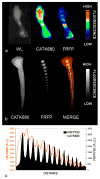Non-invasive optical detection of cathepsin K-mediated fluorescence reveals osteoclast activity in vitro and in vivo
- PMID: 19007918
- PMCID: PMC2656637
- DOI: 10.1016/j.bone.2008.10.036
Non-invasive optical detection of cathepsin K-mediated fluorescence reveals osteoclast activity in vitro and in vivo
Abstract
Osteoclasts degrade bone matrix by demineralization followed by degradation of type I collagen through secretion of the cysteine protease, cathepsin K. Current imaging modalities are insufficient for sensitive observation of osteoclast activity, and in vivo live imaging of osteoclast resorption of bone has yet to be demonstrated. Here, we describe a near-infrared fluorescence reporter probe whose activation by cathepsin K is shown in live osteoclast cells and in mouse models of development and osteoclast upregulation. Cathepsin K probe activity was monitored in live osteoclast cultures and correlates with cathepsin K gene expression. In ovariectomized mice, cathepsin K probe upregulation precedes detection of bone loss by micro-computed tomography. These results are the first to demonstrate non-invasive visualization of bone degrading enzymes in models of accelerated bone loss, and may provide a means for early diagnosis of upregulated resorption and rapid feedback on efficacy of treatment protocols prior to significant loss of bone in the patient.
Figures







References
-
- Teitelbaum SL. Bone resorption by osteoclasts. Science. 2000;289:1504–8. - PubMed
-
- Garnero P, Borel O, Byrjalsen I, Ferreras M, Drake FH, McQueney MS, Foged NT, Delmas PD, Delaisse JM. The collagenolytic activity of cathepsin K is unique among mammalian proteinases. Journal of Biological Chemistry. 1998;273:32347–52. - PubMed
-
- Drake FH, Dodds RA, James IE, Connor JR, Debouck C, Richardson S, Lee-Rykaczewski E, Coleman L, Rieman D, Barthlow R, Hastings G, Gowen M. Cathepsin K, but not cathepsins B, L, or S, is abundantly expressed in human osteoclasts. J Biol Chem. 1996;271:12511–6. - PubMed
-
- Gowen M, Lazner F, Dodds R, Kapadia R, Feild J, Tavaria M, Bertoncello I, Drake F, Zavarselk S, Tellis I, Hertzog P, Debouck C, Kola I. Cathepsin K knockout mice develop osteopetrosis due to a deficit in matrix degradation but not demineralization. Journal of Bone & Mineral Research. 1999;14:1654–63. - PubMed
-
- Gelb BD, Shi GP, Chapman HA, Desnick RJ. Pycnodysostosis, a lysosomal disease caused by cathepsin K deficiency. Science. 1996;273:1236–8. - PubMed
Publication types
MeSH terms
Substances
Grants and funding
LinkOut - more resources
Full Text Sources

